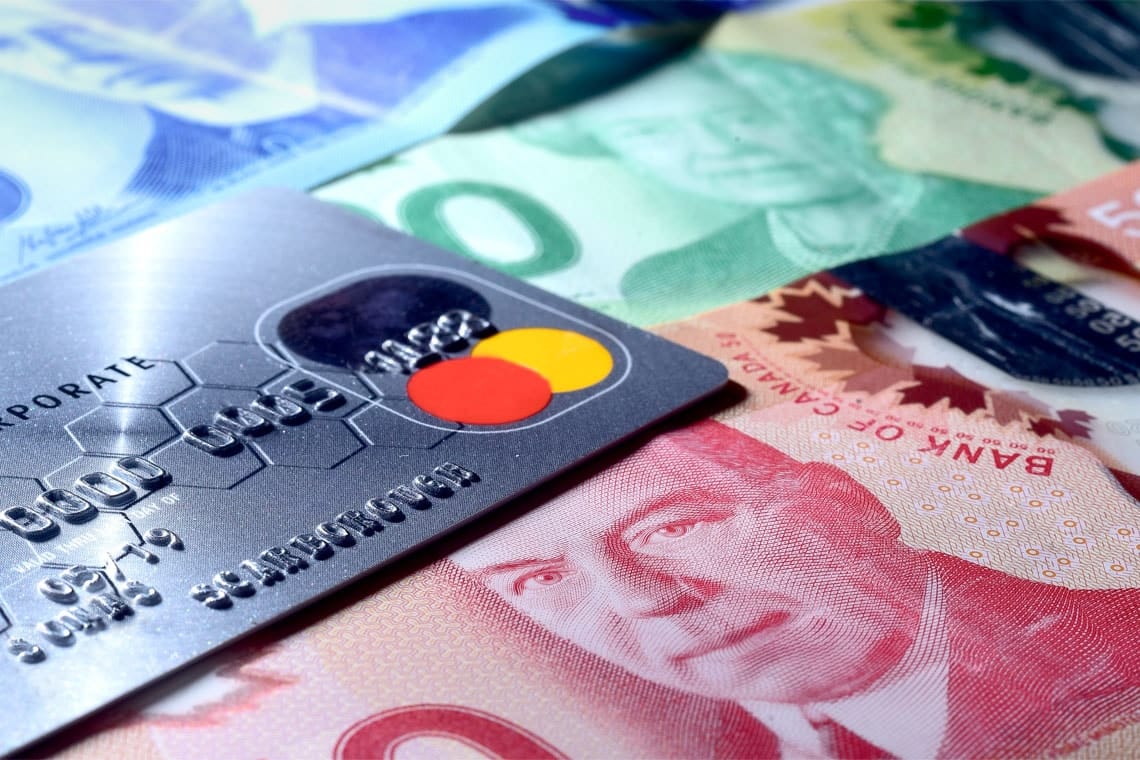As of today, Canadian businesses are allowed to charge credit card fees on purchases.
For consumers and businesses, this change is bound to send shockwaves through our spending habits, not to mention the credit card rewards space.
Let’s explore the ramifications of this dramatic news.
Canadian Businesses Can Charge Credit Card Fees
Starting today, Canadian businesses can levy a surcharge for accepting credit card payments. This fee would then be paid by customers who choose to use a credit card to make their purchase.
For the past 30 years, this wasn’t allowed. There’s actually no Canadian federal legislation preventing this; instead, it was a rule put in place by Visa and Mastercard as part of the merchant agreement that they have with businesses who decide to accept credit cards.
This policy has been beneficial for credit card companies, as it incentivizes consumers to use their cards on a level playing field with cash prices for goods and services. As a result, credit card companies make money from businesses, and businesses make money from increased sales as customers enjoy the convenience of cashless payments.
This change is part of the settlement of a class-action lawsuit brought by businesses against Visa and Mastercard, alleging that the costs imposed on merchants to accept credit cards have been punitively high.

Going forward, Mastercard has modified their merchant agreement to allow businesses to levy a surcharge on customers up to 2.4% or the credit card processing fee, whichever is lower. Consumers using debit and prepaid Mastercards are still protected from having a surcharge imposed.
Visa has yet to confirm their exact policies, but I’d guess that they’ll align closely with Mastercard. American Express is not part of the decision in the class-action settlement, and they tend to do things a bit differently anyway, so it’ll be interesting to see how they respond.
Meanwhile, the Canadian government has also been exploring legislation that would reduce interchange fees. No action has been taken yet, and discussions have been stagnant through the pandemic.
How Do Credit Card Payments Work?
Consumer credit is issued by accredited lenders, including American Express, BMO, CIBC, RBC, Scotiabank, and TD. With the exception of prepaid cards, you have to apply to get a credit card, which lets you spend money that you don’t (yet) have.
Merchants must be set up with a payment processor, such as Moneris, Global Payments, Stripe, or Square, who provide the hardware and software to accept credit card payments. They also provide merchant accounts, where money from customers is received and held before being sent to a business bank account.
Visa, Mastercard, and American Express operate payment networks, which is the infrastructure that enables money to change hands in the credit system. You can think of this as the bridge between the consumer and the business.
At every step along the way, a third party is providing a service, and they’re all taking a cut of the transaction:
- Credit issuers make money from the consumer on annual fees, interest charges, and other banking products (investments, mortgages, etc.) that they can sell by having a cardholder embedded in their system.
- Payment processors make money from the business by charging for their hardware and service fees, which may be a flat rate, a percentage of each transaction, or a package deal of any form.
- Payment networks make money from the interchange fee, which is a percentage of the transaction paid from the merchant’s bank to the customer’s bank. Networks take a small cut as the middleman facilitating the transaction, while the bulk of the fee goes upstream to the issuing bank acting as the lender.
The Relationship Between Credit Card Fees and Rewards
While there are many factors that influence credit card rewards, it is commonly understood that the interchange fee is the most important driver of earning rates for cardholders. High interchange fees mean more money to the credit card issuer, which means they can return more value to the cardholder in the form of rewards on spending.

In fact, the only jurisdictions in the world with meaningful credit card rewards are the United States and Canada. By no coincidence, we are the only two countries with high interchange fees in the realm of 1.5%, while the rest of the world is generally under 0.5%.
Each network sets interchange rates based on factors such as merchant category and card tier. For example, rewards on grocery stores are universally high because interchange fees for merchants classified as grocery stores are higher.
This is obviously great for consumers, as we have lots of choice over which card we use at which store, and the highest interchange and rewards tend to be found at stores that make up the bulk of our daily spending.
It’s also no surprise why Amex has the best rewards in the industry. They’ve cultivated an identity as a high-end, consumer-friendly brand, with a reputation for charging higher interchange fees to businesses, who sometimes respond by simply refusing to accept Amex payments.
To balance consumer incentives with the interests of businesses, the networks also set a maximum total interchange rate, which issuers must adhere to. This is why Visa Infinite and World Elite Mastercard products have income requirements: as much as banks would love to have every cardholder paying high annual fees, they need a way to limit the number of cards in circulation with high interchange fees.
What’s the Impact for Consumers and Businesses?
During the pandemic, we’ve seen a shift in the direction of a cashless society. Through that change, businesses have shined a spotlight on the fees that they are charged to accept credit card payments.
By charging a fee for the privilege of using a credit card, businesses can transfer some of the costs of accepting credit cards onto the consumer.
On the surface, this change moves the needle in a pro-business, anti-consumer direction. While this is unquestionably true, it’s not quite crystal clear that businesses will actually benefit, or if consumers will stop using credit cards.

First, the costs of accepting credit cards are already priced in. Many businesses have raised their prices over the years to account for the costs of processing credit cards, and they don’t necessarily need to levy a surcharge to make the economics work – the system has already found equilibrium.
If anything, the pricing-in of credit card fees only serves to hurt people who pay cash: they pay a higher price than they would otherwise, without reaping any credit card rewards. In the grand scheme of things, credit card fees serve to widen the wealth gap between those who can and can’t be approved for credit cards.
In the current inflationary climate, I’d be concerned that businesses will tack on a credit card surcharge, despite the costs of the system already being accounted for in their pricing. After all, I don’t expect to see sticker prices coming down to offset surcharges.
As a result, I’m not convinced that consumers will benefit from a new system of surcharges, whether paying with credit or cash.
That being said, I’m not sure most businesses will even benefit from adding a surcharge. Just because they can, doesn’t mean they will.
Such a blatantly anti-consumer policy is bound to ruffle some feathers, especially with tensions running high as the cost of living skyrockets.
Consumers vote with their wallets, and many may simply choose not to patronize establishments that levy a credit card surcharge. Small- and medium-sized businesses may risk putting themselves at a competitive disadvantage by imposing a fee on customers.

Unfortunately, large corporations are best poised to benefit. Monopoly industries, such as telecommunications and airlines, can get away with credit card fees without their business suffering.
Indeed, Telus has already fired the first shot, charging customers a fee of 1.5% on all credit card payments.
This change strikes me as excessively favouring large businesses, who already have an advantage by being able to negotiate their own interchange rates anyway. Payment networks often charge a lower percentage to their partners who do enormous volumes of transactions.
Additionally, it’s worth noting that businesses in Quebec aren’t legally allowed to add any surcharges to the sticker price, with the exception of sales tax. Whether in Quebec or the rest of Canada, I can’t see many businesses having an appetite to juggle multiple prices per product.
Also, while there are certainly costs to maintain the technology that enables credit card payments, many people overlook the costs of a cash system. With a higher risk of theft and added burden of bookkeeping, the time, money, and training required to ensure secure cash-handling procedures can easily outpace the price and convenience of digital payments.
Because these hidden costs of cash don’t show up on a balance sheet, many short-sighted business owners are oblivious to the benefits of accepting credit cards.
I’ll continue using credit cards, as consumers can still benefit immensely. As products, credit cards don’t just offer rewards; they also offer things like fraud protection and chargebacks, which you don’t get with other methods of payment. As long as these unique benefits continue, credit card fees are more than just a cash grab by payment networks and banks.
What’s the Impact on Credit Card Rewards and Fees?
In spite of the potential for credit card surcharges, interchange remains unchanged. This means that, at least for now, credit card issuers have no reason to reduce their rewards rates, or to increase their fees for cardholders.
Credit card usage may take a short-term dip – it certainly won’t increase as a result of the potential for higher costs for consumers. For banks, with interchange representing a greater profit centre than interest, they may look for new ways to incentivize consumers to use credit cards frequently and for large purchases.
As a best-case scenario, we may see higher signup bonuses, or perhaps even higher earn rates on daily spending, as credit card issuers compete with each other more aggressively for a smaller market of cardholders.

However, it’s also possible that we move towards a long-term equilibrium where credit cards take a back seat. If credit card acceptance falls out of favour with businesses, payment networks may need to reduce interchange fees to lure merchants back in.
Of course, this would have the ripple effect of reducing rewards for cardholders. This could eventually lead to a system like the European Union, where costs to business are low and rewards to consumers are low, or it might end up a step further like in Australia, where credit card culture isn’t really a thing.
Meanwhile, banks in low-interchange jurisdictions make up for this on their balance sheets with high interest rates. So if you’ve been feeling guilty about transferring wealth from the underbanked, cash-paying folks to your creditworthy self via higher prices and higher rewards, rest assured that the middleman will always find a way to take its cut.
Most likely, though, as costs are simply being shuffled from the business to the consumer, I don’t think much will change with respect to rewards, at least not unless the federal government introduces legislation to reduce interchange fees.
Conclusion
With Canadian businesses being allowed to impose surcharges on credit card payments, the pendulum on the credit card system is moving in a decisively anti-consumer, pro-business direction.
Regardless of how you feel about the relationship between interchange and rewards, it’s hard to deny that credit card payments are inefficient. Value for businesses and consumers alike is being lost as “friction” to middlemen, namely credit issuers and payment networks.
Unfortunately, I’m concerned that credit card surcharges are the wrong solution. Instead of improving efficiency for the benefit of both parties to a transaction, the costs of the system are simply being shifted around.
I’m not convinced that this will benefit businesses or consumers on balance. We’re opening up the possibility of higher prices and less choice, all while fanning the flames of an economy on edge and a widening wealth gap.
Hopefully the effects will be minimal, and the decision-makers in our society will pull more effective levers to address any systemic deficiencies. With such unprecedented changes after so many decades of the status quo, it’s anyone’s guess how businesses, consumers, credit card issuers, and legislators will respond next.
Until then, savvy consumers like you should continue to reap the benefits of the credit card industry to the best of your ability. I’m optimistic that we will continue to gain more by using credit cards than the additional costs we may face.
Finally, these potential changes are also a sobering reminder that credit card rewards are merely a tool in the toolbox towards aspirational travel, and it’s essential to remain adaptable and creative as systems change outside of our control.




















Great article – very interested to hear if AMEX purchases are exempt from having their interchange fees passed on given they weren’t a part of the judgement. Any insight would be good to hear as I’m seeing some chatter online about this.
My understanding is that Amex never blocked merchants from passing fees onto customers, but it would be disadvantageous for the business to bother accepting Amex and attracting their cardholders only to slap them in the face with a surcharge. With the new rules for Visa and Mastercard, I see merchants who accept Amex following suit with fees for all, or fees for none. Regardless of Amex’s rules past or present, I highly doubt that savvy merchants would bother charging separate prices depending on the customer’s payment network of choice – it’s an enormous hassle for bookkeeping and a terrible customer experience.
I have the same question. I’ve preemptively switched the card I’m using to pay for my Telus bill from Visa to AMEX.
Finally, a good article on PoT. It’s been a long time coming!
Great assessment and a thoughtful analysis of the situation and the possible effects we’ll see
Small businesses will suffer. What are the odds stores like Walmart and Canadian tire will drop the fee if you use their store card. I’d bet my buttons.
The fastest way imagineable that any company I do business with is to begin charing this fee. I actually feel bad for the small businesses that will be harming themselves by charging these fees because I’m sure most people feel this way as well and will drive business away immediately, and its not like the price for these fees isn’t already baked into the price anyway this just feels cheap and slimey.
Its unfortuante but I feel that this will also strongly discourage a lot of consumer behavior as most people spend more with credit vs cash/debit anyway so charging your customers excess to do business with you is also asking for customers to spend less with you and less often.
Feels like a lot of short sightedness here from the companies that fought for this.
Credit cards also benefit the consumer in terms of purchase protection against fraudulent charges or when a company fails to follow through with their end of the bargain. This fee is extremely anti-consumer and encourages consumers to boycott businesses that charge the fee. Is it really economical to pay high wages for staff to deal with large sums of cash or have it be stolen? Companies that don’t accept other methods of payment should be forbidden from passing this fee along to consumers (again) as this fee has already been added to the prices of goods for years, and as mentioned, isn’t going to be lower any time soon. Credit card processing fees are also tax deductions for businesses as a cost of doing business… So it’s an expense, kinda. And finally, if a business is paying a lot in credit card fees, then they are likely profitable. Would they have the same profit if they didn’t accept credit cards at all? Doubt it.
Well articulated arguments, providing context, and suggesting why for some Merchants, adding such a fee will cost them more than they gain.